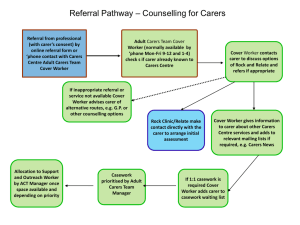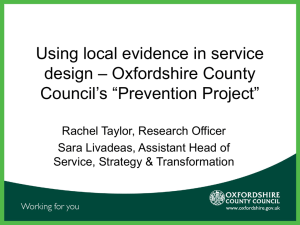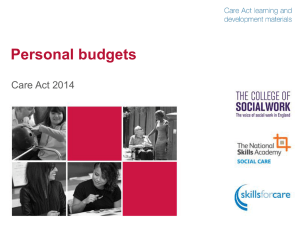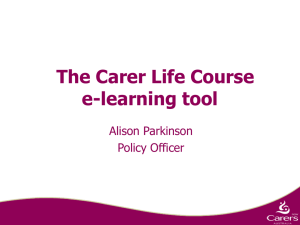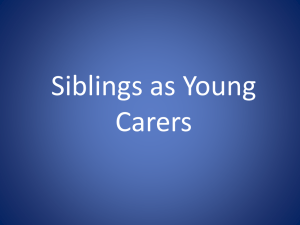Jamal
advertisement
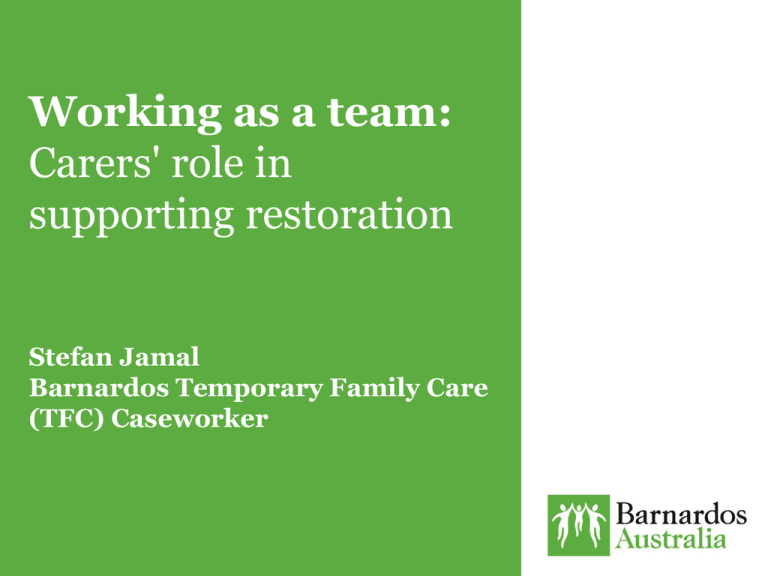
Working as a team: Carers' role in supporting restoration Stefan Jamal Barnardos Temporary Family Care (TFC) Caseworker OVERVIEW • • • • • Barnardos Practice Framework The Study Findings Practice Implications Questions BARNARDOS PRACTICE FRAMEWORK • Barnardos’ Temporary Family Care (TFC) is short-term, crisis care. Historically a restoration focus. • Barnardos believes a positive relationship between birth families and carers is best practice in this context; - Stability for children - Security for families – maintaining engagement - Support restoration • Avenues for this relationship; - Carer home as contact venue - Carer supervise contact - Carer transport children to contact - Direct communication with birth families • 30 years practice history with positive practice outcomes • Evidence informed practice • Inclusive foster caring promotes better outcomes for children (Holman, 1975). Later supported by a study by Sally Palmer (1996) in Canada which found links between inclusive practice and placement stability. • “carers’ involvement in contact may be a central part of plans to support reunification with birth families” (Sen & McCormack, 2011) • “problems arise when infants need to leave their carer and travel to family contact without regard for their attachments or routines” (Humphreys & Kiraly, 2010) We believe this is true… but found it was happening less… RESEARCH CONTEXT • Anecdotal trends cited by program managers: - Reduced use of carer home - Increased use of contact workers • International trends for carer involvement: - Reduced use of carers’ homes (Sen & McCormack, 2011) - Increase in the “Contact Centre” model (Triseliotis, 2010) - Contact used for assessment (Triseliotis, 2010) So we decided to figure out what was happening, and why. THE STUDY Three research questions: 1. What is current contact practice in Barnardos TFCs regarding the involvement of carers in contact? 2. What are the factors influencing the choices made about carers involvement in contact? 3. Can greater carer involvement in contact be achieved? If so, how? SCOPE & METHOD • Research initially intended for internal review • Scope limited by resource availability - time limited • Research Method: - Across four NSW Temporary Family Care (TFC) programs - Administrative Data from case notes – LACES & MyStory - Interviews with senior members of staff FINDINGS • This presentation is a summary of key/relevant findings • Only key message of each graph • Email list if you’d like full research paper RESEARCH QUESTION 1 What is current contact practice in Barnardos TFCs regarding the involvement of carers in contact? (Data from administrative files) VENUE FOR CONTACT CARERS SUPERVISING CONTACT CARERS TRANSPORTING TO AND FROM CONTACT WHEN DID BIRTH FAMILIES MEET THE CARER? • Birth families met the carer in 23 out of 24 cases METHOD OF COMMUNICATION BETWEEN BIRTH FAMILY AND CARER • 19 out of 24 at “handover” before and after contact • 4 cases telephone communication • 3 cases only through a Barnardos caseworker • (2 cases no adequate data) RESEARCH QUESTION 2 What are the factors influencing the choices made about carers’ involvement in contact? (Data from interviews) COMPETING PRESSURES • All interviewees acknowledged and understood the importance of involving carers, however cited competing pressures as a road block. “Just because it’s not happening at the moment, it’s not that we are against it or we’re not aware of the policy... I guess it’s just that on the ground when you’re working, it can be quite difficult to implement.” (Interviewee B) FEAR OF “RISK” • Risk of the “unknown”: “A parent is an unknown risk, we don’t know them well enough, or enough about their history to determine whether they would be suitable to have contact in a carer’s home” (Interviewee B) • Risk around issues of Mental Health and Drug and Alcohol use • In line with growing concerns about “risk” in social work practice (Webb, 2006) THE CARE PLAN • All interviewees identified a care plan for restoration as a reason to involve the carer in contact • Interviewees identified a shift towards more involuntary placements and less restorations CARER SKILLS • Concern about “Carer Professionalism” - Carers becoming “friends” with birth families - Inability to/lack of confidence in setting boundaries OFFICE DESIGN/STRUCTURE • One interviewee identified constraints of the office building, where carer and birth families enter from different parts of building • Researcher observations of other facilities as more appropriate So then, what is the carer’s role in supporting birth families and supporting restorations? PRACTICE IMPLICATIONS • Policy acknowledgement of the pressure on workers (risk in practice, protecting carers) • Work within risk context to create safe spaces for carer to engage with birth family - Meetings as early as practically possible - Caseworker support in meeting and ongoing - Organic, safe spaces • Maintaining the critical carer roles of transport and handover throughout placement • Keep high level roles (supervision and contact in home) for restoration work • Emphasising and explaining the importance of these roles in carer training • Worker training toward greater understanding of importance of carer involvement • Work with TFC teams about where we could be better advocates for greater carer involvement A thought to take away… Wider contextual shifts and trends can slip so easily into our practice. It is important to continually reflect on whether our practice aligns with agency values. REFERENCES • Holman R (1975) The place of fostering in social work British Journal of Social Work 5(1): 3–29. • Humphreys C & Kiraly M (2010) High-frequency family contact: a road to nowhere for infants Child and Family Social Work • Palmer, S E (1996) Placement stability and inclusive practice in foster care: An empirical study Children and Youth Services Review 18(7): 589–601. • Sen R and McCormack J (2011) Foster Carers' Involvement in contact: Other professionals views Practice: social Work in Action 23(5): 279- 292. • Triseliotis J H (2010) Contact between looked after children and their parents: A level playing field Adoption and Fostering 14(3): 59-64. • Webb S A (2006) Social Work in a Risk Society. Basingstoke: Palgrave MacMillan. QUESTIONS?

